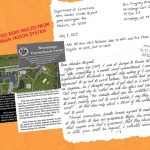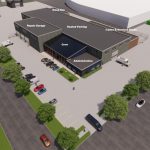Life stories writ small
 A frozen pond is a perfect place to ice skate and it’s hard to miss the spring rains and snowmelt that fill our rivers and lakes, but in the summer people spend much more time sitting by the lake with a book or hiking along one of Milwaukee’s rivers. Many of the animals are more active in summer too: Ring-billed gulls scream overhead at the beach, painted turtles silently sun themselves on the riverbank while catfish lurk at the bottom. These big ones are obvious, but what about the little guys? It’s easy to forget the smallest residents of our rivers, but their position at the bottom of the ecosystem’s food chain ensures that those who live there pay close attention to them and their life cycles.
A frozen pond is a perfect place to ice skate and it’s hard to miss the spring rains and snowmelt that fill our rivers and lakes, but in the summer people spend much more time sitting by the lake with a book or hiking along one of Milwaukee’s rivers. Many of the animals are more active in summer too: Ring-billed gulls scream overhead at the beach, painted turtles silently sun themselves on the riverbank while catfish lurk at the bottom. These big ones are obvious, but what about the little guys? It’s easy to forget the smallest residents of our rivers, but their position at the bottom of the ecosystem’s food chain ensures that those who live there pay close attention to them and their life cycles.
The algae that give our ponds their greenish tint photosynthesize like plants, but don’t have roots, stems and other formal structures found in a true plant. Algae is an important food source for tadpoles and many small fish, and even water-dwellers like bass and great blue herons who don’t eat algae directly can often trace their food chain back to it. In fact, some researchers have noticed algae’s skill in turning the sun’s energy into a useable form and are exploring it as the next biofuel.
Excess nitrogen and phosphorus – nutrients found in animal waste, runoff from agricultural and lawn fertilizers, and detergents containing phosphates – can cause algal blooms; rapid increases in algae population. So can warming water temperatures and a decrease in the turbidity or cloudiness of the water. Though healthy levels of algae provide the foundation for the larger critters swimming in our waters, it can be hard to love the sight and smell of the carpets of Cladophora that wash up on Milwaukee’s beaches during the summer.
Increased algae levels can cause more problems than just a stinky smell on the beach. These additional algae eventually die and are broken down by oxygen-consuming bacteria. Lower levels of dissolved oxygen in the water makes it difficult for many macroinvertebrates like mayflies and stoneflies to get enough oxygen, so these critters are generally found only in healthy ponds and rivers.
“Aquatic macroinvertebrate” is the term given to all the critters without backbones big enough to be seen with the naked eye and includes thing from the crayfish and snails in residence in the muck at the bottom of the pond to the water striders skating on top. Many of these macroinvertebrates are insects – a picky club you can only get into if you have an exoskeleton, six jointed legs, and three body parts. It’s relatively easy to pick out the head, thorax and abdomen on an ant, but it takes a closer look to find them when looking at many other types of insects. Insects also have segmented legs, compound eyes and antennae, and often have wings as adults.
All insects need to breath oxygen, but they’ve adapted many ways to accomplish this simple task. Water boatmen carry a bubble of air under water with them; their primitive scuba tank makes them a little shiny and may double as camouflage. Water scorpions and larval mosquitoes have straw-like breathing tubes on their abdomen, and must back up to the surface of water to take a breath. Other insects have gills of some form: mayfly gills are on their …’tails’ and stonefly gills are on their legs. Dragonfly gills are actually inside their abdomen, and they can shoot themselves forward as they push water out of them.
Many insects fly, but most are not technically flies. If you look closely at adult true flies (Order Diptera) like midges or mosquitoes, you’ll notice that they only have one pair of wings and a club-like pair of halteres, a remnant of their hindwings. Flies go through complete metamorphosis before they reach the adult stage, and larval flies look nothing like their future winged selves. Newly-hatched mosquito larvae resemble a prickly worm. They scoot through the puddle, pond, or other non-moving body of water and periodically come to the surface to breathe air through a breathing tube on their backsides. After molting through four stages as larvae, and a spending few days as a question mark-shaped pupa, they become the adult mosquitoes we’re very familiar with.
Dragonflies’ life cycles are a bit different. We may catch a glimpse of a beautiful blue dragonfly as it zips through the air, but may not realize that most of its life was spent as a drab-colored wingless water-dweller. They (as well as water boatmen and many others) undergo incomplete metamorphosis, meaning they don’t have a pupa stage and molt directly from their final larval stage into adulthood.
There’s a lot more going on in your local pond or river than you’ll notice as you pass by. That swarm of midges you see swarming nearby may be preparing to lay eggs, or you might notice a pair of compound eyes staring right back at you. Take a closer look and dive beneath the surface to see what makes that pond really tick.
–by Tory Bahe




















